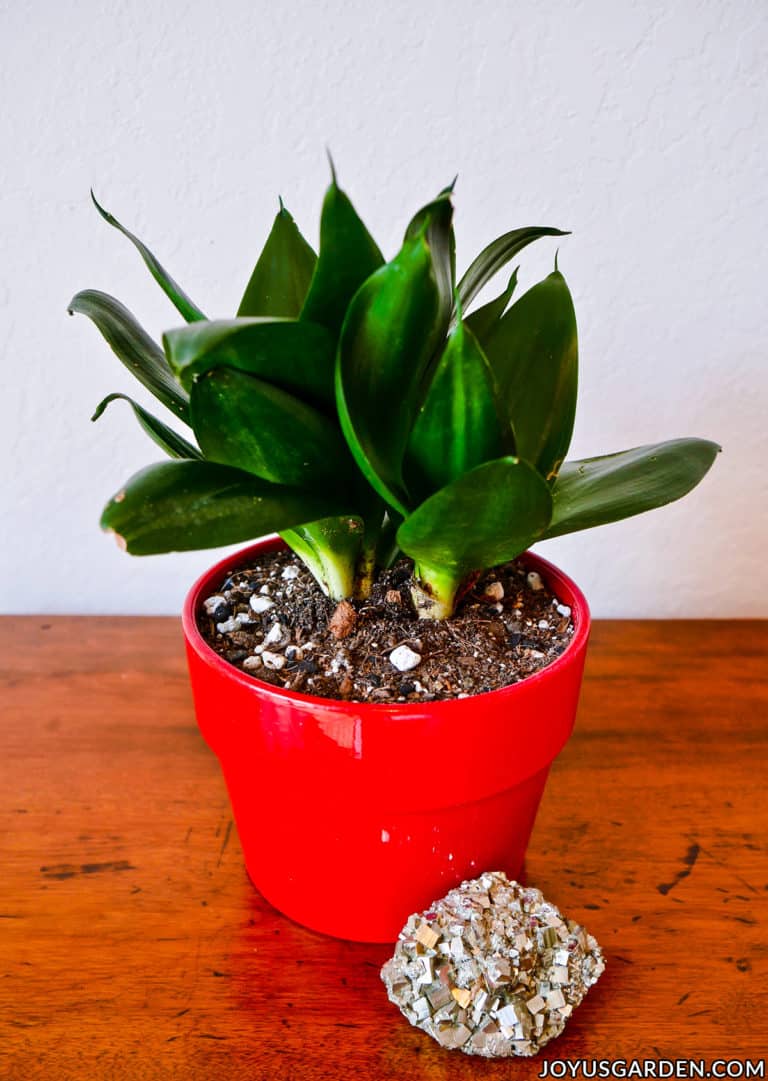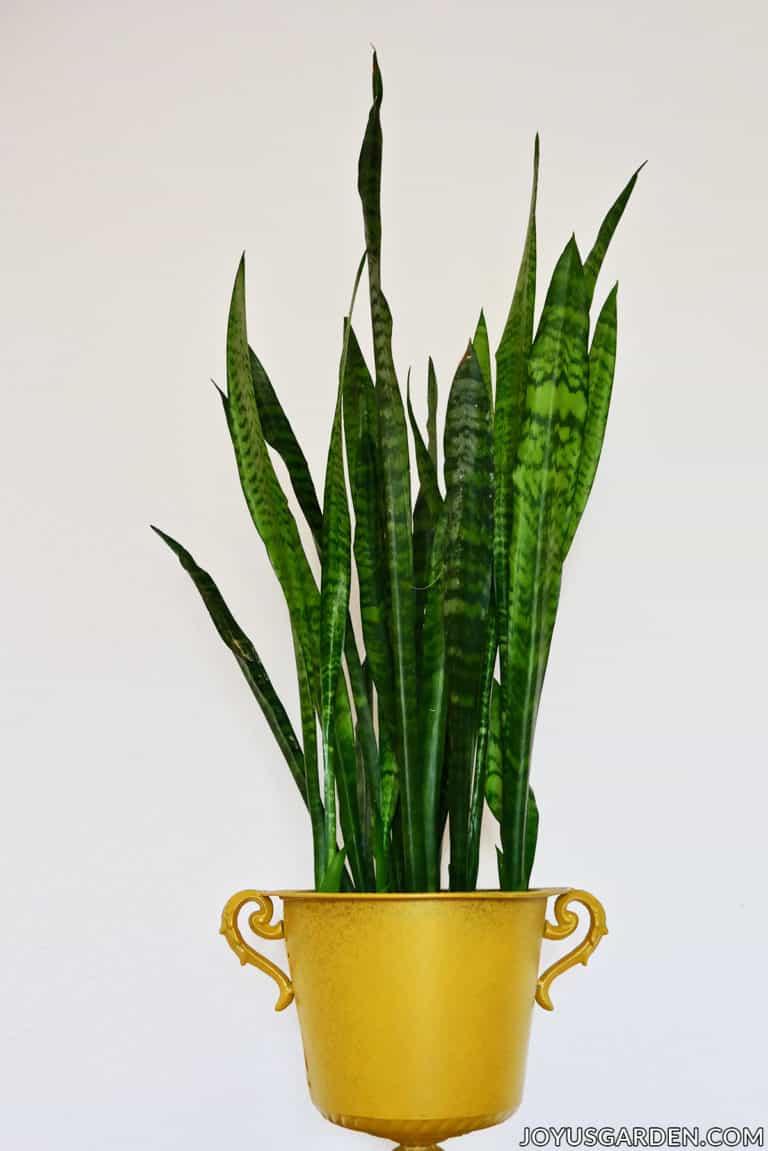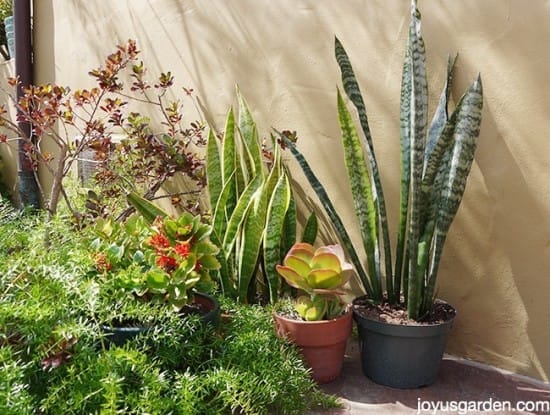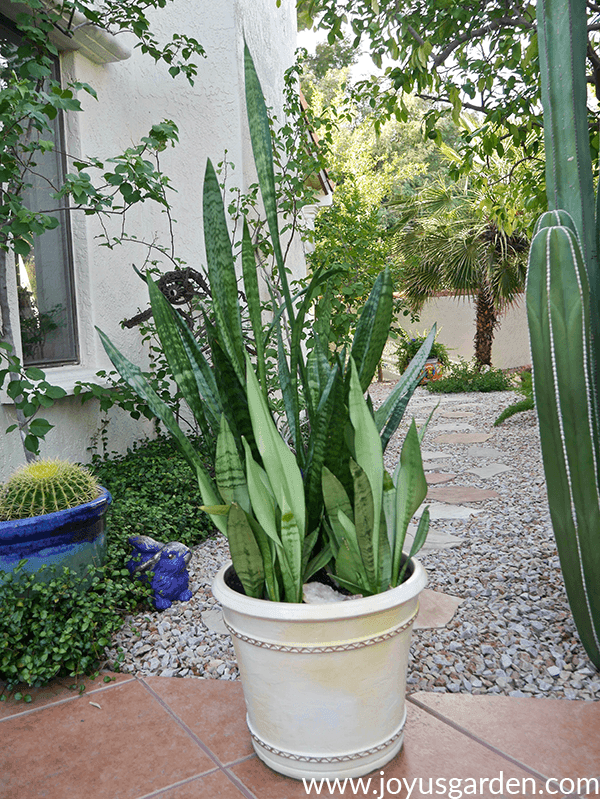5 Awesome Types Of Snake Plants, Plus Key Care Tips
So many Snake Plants, and I want all of them to come home with me! You can find them in a variety of sizes, leaf patterns, colors, and forms but all have in common the trait of easy care. I want to share with you five types of Snake Plants that you might want to add to your plant collection.
Snake Plants and topics related to growing them are very popular here on our website. We’ve done many posts and videos on their care but I’ll do a Cliff Notes version here to start off with.
Snake Plant Growing Tips

Botanic Name: Sansevieria (species and varieties vary) Common Names: Snake Plant, Mother-In-Law’s Tongue
Note: Sansevieria was recently reclassified. You may now see them listed as the Dracaena genus, for example, a Dracaena fasciata is the same as a Sansevieria fasciata.
Snake Plants are a staple of any plant collection. Below are a few care points. This post has more details on growing this easy plant: Snake Plant Care: How To Grow This Diehard Snake Plant
Growth Rate:
In general, Snake Plants grow slowly to moderately indoors. This will vary a bit as some species/varieties will grow faster. If your light levels are low, then the growth will be slower.
Light/Exposure
Snake Plants aren’t picky as to light levels, but bright light, a moderate exposure, is their sweet spot. Make sure it’s indirect light because those succulent leaves will burn in the direct, hot sun.
I’ve seen them growing in high-light situations as well as low-light. Many can tolerate low light conditions, but you won’t see much growth.
The Sansevieria varieties with darker leaves tolerate lower light levels better. The ones with brighter leaves, like the Gold Star pictured below under “Types of Snake Plants”, need higher light levels to keep the color strong.
A Snake Plant isn’t particularly fast-growing, but in low light, will assuredly be a slow-growing plant.
Many Snake Plants have white flowers (or greenish or yellowish) and will flower only if the light levels are adequate and to their liking. By the way, those flowers are very sweetly scented!

Watering
This is a succulent plant that doesn’t require much water. They are ideal plants if you don’t want to be watering your plants every 7 days!
They have somewhat fleshy leaves that store water as do their underground stems called rhizomes so watering frequently will do them in.
You want to water them when the soil is completely dry. I can’t give you an exact time frame because how often depends on your home’s environment, the pot size, and soil composition.
I love Snake Plants because I live in the Arizona desert and they require little water in comparison with my other tropical houseplant babies. In the hot, sunny summer months, I especially appreciate this!
Do you have questions about growing Sansevierias? We’ve got you covered with Answers To FAQS About Snake Plants Here.
Temperature
They’re a hardy, versatile plant all the way around. Snake Plants can handle cool temperatures as well as warm temperatures.
Many can handle cold temperatures down to 25-35F. I have one that grows year-round on my shaded north-facing covered patio here in Tucson where the temps can get down to 28F in winter and over 100F in the summer.

Humidity
Again, they’re versatile indoor plants that can also handle the dry air in our homes just fine. I have nine Snake Plants and there are barely any brown leaf tips on any of them.
The one growing out on the patio is a different story. Almost all the leaf tips are tinged with brown.
Are your Sansevieria leaves falling over? This can happen as they grow. Find out more about Snake Plant Leaves Falling Over here.
Fertilizing
I fertilize my Snake Plants from March through October. We have a long growing season here in Tucson and my houseplants appreciate it. For you in a different climate zone, feeding two or three times per year may do it for your indoor plants.
I feed my container plants indoors and outdoors with Grow Big, liquid kelp, and Maxsea three to six times during the growing season. By the way, I alternate fertilizers and don’t use them all together.
Other options you might consider are would be kelp/seaweed fertilizer and Joyful Dirt. Both are popular and get great reviews.
Don’t over-fertilize (use too great a quantity and/or do it too often) because salts can build up and lead to root burn.
The lower the light, the less often you’ll fertilize.

Soil Mix
Snake Plants are succulents and don’t like too much water too often. The soil needs to dry out between waterings. You want it to be light, well aerated, and to allow good drainage. Excess water leads to root rot.
I use approximately 1/2 potting soil to 1/2 succulent and cactus mix. The potting soil is formulated for houseplants and the DIY Cactus & Succulent Recipe I make up contains coco chips, coco fiber, and pumice. I add a couple of handfuls of compost and worm compost blend for extra goodness as I go along.
I won’t detail the repotting process here as you can refer to the two posts and videos below for all the details and steps.
I recently repotted my 5′ Snake Plant, see how I did it & soil mix to use: How To Repot A Large Snake Plant. Here’s a general guide to Repotting Snake Plants Plus The Soil Mix To Use.
Pests
In all the years I’ve grown them, mine have never had any pest infestations. I once saw a Snake Plant infested with spider mites. Also, keep your eye open for mealybugs.
Toxic To Pets
They’re considered to be toxic to cats and dogs. I always consult the ASPCA website for this information. You can read in what way they’re toxic right here. I’ve had kitties and plants my whole life, and they’ve never paid any attention to any of my Snake Plants. Soft, crunchy-leaved Spider Plants are a different story – my Tazzy cat loves them!

My S. trifasciata stands over 5′ tall now. I love the dark green leaves on this one. It’s hard to find an extra-large sturdy good looking basket that doesn’t cost an arm & a leg.
Types Of Snake Plants
There are so many different types of Snake Plants on the market. I’ve been houseplant shopping for many years now and for quite some time, was always seeing the same three or four varieties. In the past ten years, more are being grown and sold on the houseplant market so now we have many choices.
Below are five new Snake Plants that I’ve recently added to my collection. In case you’re wondering, I bought them at Mesquite Valley Nursery here in Tucson and at Berridge’s Nursery in Phoenix.
Etsy has a decent selection of Snake Plants offered by quite a few sellers.
I list the ultimate size each one will get growing indoors. I bought mine as 4″ plants, so they won’t reach a decent size for a while. And that’s fine with me because I don’t have a lot of remaining surface space without my house looking like a nursery!
If you want a fun plant project, propagating Snake Plant leaves is easy to do. Here’s a full guide on Propagating Snake Plant Leaf Cuttings In Soil
1) Sansevieria Stuckyi
This one, aka Elephants Tusk Plant, gets large, about 6′. Mature plants look different, with more upright leaves than my little one which is horizontal and vertical in form and darker green in color. To me, it looks like a fat Horsetails Plant as it grows.
2) Sansevieria Mikado Fernwood
A larger Fernwood Mikado caught my eye in the greenhouse. With its many narrow leaves, it reminds me of one of the upright grasses, which are among my favorite plants to mix into the garden border. The Fernwood Mikado stays fairly vertical just like the Stuckyi.
The larger one I saw was about 2′ tall. They reach 3′ tall when mature. This plant is good for tight spaces where you also want a bit of height.
3) Sansevieria cylindrica Bonsal
This one is a favorite Snake Plant variety and is so appealing because of its fan-like shape. The Starfish Snake Plant is a unique-looking houseplant, that’s for sure. I love the silvery green foliage and the bands that wrap up and down the cylindrical leaves.
It reaches about 1′ at maturity.
4) Sansevieria Hahnii Green Jade
The Green Jade Snake Plant (also called Jade Snake Plant) is one of Bird’s Nest Sansevierias. This dwarf variety really stands out because it’s such a deep green and would look good even in a wildly patterned pot.
It ultimately reaches 1′.
5) Sansevieria Gold Star
This is another dwarf Snake Plant. The Gold Star really catches your eye with its bright yellow foliage. Because of the vibrancy of the foliage, it needs more light to keep it this way.
It stays nice and compact reaching 10-12″.
Do you have questions about growing Sansevierias? We’ve got you covered with Answers To FAQS about Snake Plants here.
Types Of Snake Plants Video Guide
FAQs About Types Of Snake Plants
There are many different species and varieties of Sansevieria plants. In terms of how many are sold in the houseplant trade, I’d hazard a guess somewhere between 30-40.
Among the most popular are Sansevieria trifasciata which includes the popular Sansevieria Laurentii, Sansevieria cylindrica (African Spear Plant), the dwarf Bird’s Nest Sansevierias like Golden Hahnii, Black Gold and Jade, Starfish Snake Plant, Futura Robusta, Twisted Sister, Moonshine, and Bantel’s Sensation.
There are many Snake Plant varieties for you to choose from so I’d say the one that you can actually find to buy and like the best! It’s all a matter of preference (some have broad leaves, some cylindrical leaves, some sword-shaped leaves, and some are bird-nest-shaped) so it depends on what appeals to you and the amount of space you have.
Some Snake Plant varieties need a bit more light than others, but in general, they’re very versatile. And they all share this one thing in common: ease of maintenance.
All Snake Plants are easy so the choice is yours.
If you get a dwarf sansevieria, they grow slowly and there’s no need for frequent repotting. I love them because I have many indoor plants that grow like crazy, and need repotting and frequent pruning.
The large Snake Plants (in 8″ pots and up) are extra easy if you’re lax with the watering or travel frequently because they don’t need watering as often as the smaller ones. For instance, I water my 5′ Sansevieria trifasciata (in an 18″ grow pot) once a month in the summer and every other month in the winter.
Yes, you can because all of them share the same basic growing requirements. The varieties with bright foliage need a bit more light to keep their color vibrant.
Snake Plants grow and spread horizontally by underground stems called rhizomes. Just pay attention to what sizes you’re planting together because the larger growing Snake Plants will eventually crowd out the dwarf varieties. And, they have a very strong root system.
For instance, I had a Sansevieria masoniana (Whale Fin Snake Plant) planted in my front garden in Santa Barbara. It wasn’t dense growing, but it had big, broad leaves. It could eventually take over a Bird’s Nest Sansevieria which only gets 10-12″.
All shades of green – light green, dark green, medium green, silvery-green, and grey-green. Some have leaf margins edged in yellow, and others have leaf variegations (stripes or bands) in different shades of green and also white.
Yes, it is referring to the same plant. All plants are classified by botanical names that include a genus and species and sometimes a variety or cultivar. Sansevieria is the genus and Snake Plant is one of the common names along with Mother In Law’s Tongue.
Oh if it were that cut and dry! Occasionally a plant gets reclassified which always drives me crazy because it’s hard enough to learn those Latin names the first time around. The genus Sansevieria has just been replaced with Dracaena (you may be familiar with the popular floor plant Dracaena Lisa) although they’re still currently being sold as Sansevierias.
So if you see a plant labeled as Dracaena trifasciata and not Sansevieria trifasciata, just know it’s a Trifasciata Snake Plant.
In a location that’s bright with indirect sunlight. Snake Plants are a good choice for any room in your home with windows as long as they’re not sitting in the direct sun. I have them in almost every room in my house because they’re a breeze to care for, like hardly any effort at all!
Conclusion: These are 5 wonderful types of Snake Plants to have in your home. They make great gifts for the beginning gardeners in your life. There are so many more different varieties of Snake Plants I’m sure you can find at least one to love.
Looking for more Snake Plant Care Tips? We have you covered right here: Snake Plant Care: How To Grow This Diehard Snake Plant
Happy gardening,











